The term patient-centric is about ensuring the needs and perspectives of the patients are taken into consideration while maintaining scientific rigor for a clinical trial. Pharmaceutical sponsors have begun engaging patients in the trial design, seeking input and acknowledging the importance of this input in conducting a successful clinical trial.
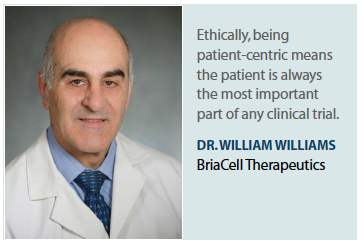 Patient-centricity can be enhanced through the use of technology solutions. In the last couple of years, there has been an effort for bring-your-own-device (BYOD) in the ePRO market. Additionally eConsent is becoming popularized among big pharma. All of these methods create more source-driven and accurate clinical data for researchers and are significantly more convenient for patients than traditional methods.
Patient-centricity can be enhanced through the use of technology solutions. In the last couple of years, there has been an effort for bring-your-own-device (BYOD) in the ePRO market. Additionally eConsent is becoming popularized among big pharma. All of these methods create more source-driven and accurate clinical data for researchers and are significantly more convenient for patients than traditional methods.
Because of the digital health revolution, healthcare in general is getting more patient-centric, says Brett Davis, Deloitte Consulting principal and general manager of ConvergeHealth. “This creates a myriad of opportunities for patients across their life journey, including when they become a patient," he says. “Patient-centered clinical trials are a key component of this digital learning healthcare system that should reduce the cost, time, and quality of innovation for life-changing cures. New digitally connected networks are enabling researchers to design trials around real-world patients."
The digitization of healthcare has enabled leading firms to undertake efforts to personalize the clinical trial experience, Mr. Davis says. “A platform-based approach that uses technology reduces the burden on participants, making it easier for patients to find and participate in trials," he says. “By streamlining study consent, enrollment, and execution, a digitally enabled personalized clinical trial is easier for the patient to join and removes a barrier to study adherence."
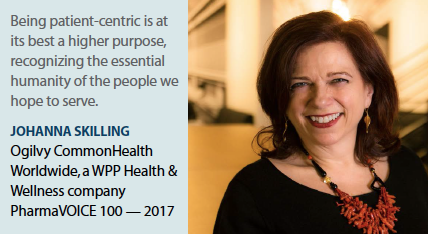 Mr. Davis says these trials should be designed with a focus on patient experience and use digital engagement to drive that better experience through monitoring and adherence.
Mr. Davis says these trials should be designed with a focus on patient experience and use digital engagement to drive that better experience through monitoring and adherence.
“There is also an opportunity for companies to seek out and use learnings about what experiences work for which patients and apply that knowledge," he says.
But the industry needs to move beyond the basics of text message reminders or study apps, says Marie Emms, head patient engagement, site and patient access at Syneos Health.
“We should be looking at how to leverage technologies that patients are already engaging with to make it easier for patients to participate in trials and monitor their progress, such as apps like Skype, WhatsApp, and many others that are used every day by young and old alike to keep in touch with each other," she says. “In some countries, patients are also able to speak to a primary care physician through a similar platform, rather than an in-office visit. We need to start thinking about these applications and how they can be used to best support patients in future clinical trials. The technology already exists in the consumer world; we just need to think about its application to clinical trials."
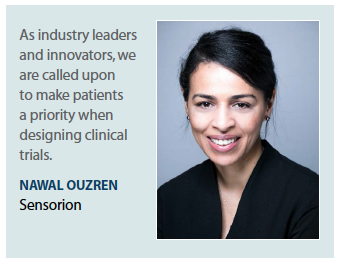 Anthony Costello, VP, mobile health, Medidata, says concerns about security, privacy, and usability, however, paralyze many companies from moving quickly through pilot stages and into full adoption.
Anthony Costello, VP, mobile health, Medidata, says concerns about security, privacy, and usability, however, paralyze many companies from moving quickly through pilot stages and into full adoption.
“We live in a world now where almost every patient carries a supercomputer in his or her pocket all day, every day, and is willing to use it to make significant contributions to research," he says. “Faster drug development timelines will require that more studies use more technology to move more data inexpensively from the source to the analysis dataset."
Engaging Patients in Trials
Ethically, being patient-centric means the patient is always the most important part of any clinical trial, says William Williams, M.D., president and CEO, BriaCell Therapeutics. “Scientifically, this means finding the best therapy available — approved or experimental — for each patient. Clinically it means taking into account the entire patient’s situation, including medical, psychological, and sociological, in a clinical trial when making decisions about their care."
Industry experts agree patient-centricity begins with the patient. To build a patient-focused trial, sponsors must begin by understanding the needs of the patient population, how patients manage their disease and its progression, and potential burdens related to study visits and procedures. Insights gained from patients, caregivers, and advocacy groups can provide sponsors with the unique insights that need to be considered to design a trial that will engage that specific patient from start to finish.
“As industry leaders and innovators, we are called upon to make this a priority when designing clinical trials," says Nawal Ouzren, CEO of Sensorion. “In our therapeutic area, it is imperative that we design patient-centric clinical trials that address the complexity of the inner ear. For example, there are no existing methods to cure acute unilateral vestibulopathy (AUV), which is a cause of acute vertigo, making it difficult to assess outcomes for treatment. Most importantly, we have to rely on the self-reporting of the patient in the form of qualitative assessments."
Jonca Bull, M.D., VP, PPD Consulting, says a patient-centric trial means that patient input has been engaged from the earliest stages of exploration.
 “As was seen in the FDA’s structured approach to the patient-focused drug development meetings, patients are important guides to what’s working and what’s not," Dr. Bull says. “Having this type of information at the earliest stages can direct protocol development for an indication that has a much higher probability of success to meet its goals. Patient input supports better-informed inclusion and exclusion criteria, raising screening success, and grounding trial execution in the pragmatic realities that keep patients in trials and minimize dropouts."
“As was seen in the FDA’s structured approach to the patient-focused drug development meetings, patients are important guides to what’s working and what’s not," Dr. Bull says. “Having this type of information at the earliest stages can direct protocol development for an indication that has a much higher probability of success to meet its goals. Patient input supports better-informed inclusion and exclusion criteria, raising screening success, and grounding trial execution in the pragmatic realities that keep patients in trials and minimize dropouts."
Once patients are in the study, patient-centricity also means ensuring that patients have the knowledge and support to understand why their commitment is important to stay engaged through to the final study visit.
Patient-centric clinical trials should mean that patients have an active role in planning and developing aspects of clinical studies, as well as providing crucial feedback throughout the process.
“There’s a clear differentiation between what patient-centric clinical trials mean today and what it should mean or — better yet — how we as an industry can make changes to make the clinical development process truly patient-centric," says Olivier Chateau, CEO and co-founder, Health Union. “I fear that many in the pharma industry will look at the incredible technological advancements — from eConsent to tracking apps to tablets at point-of-care — made to increase efficiency throughout study planning, recruitment, execution, and data collection, and will confuse them with patient-centricity."
 Mr. Chateau says Health Union, through its own research, has found that patients want to be involved in clinical trials; almost 70% of patients said — through a poll of its health condition community members — they are either interested or very interested in participating in the clinical trial process.
Mr. Chateau says Health Union, through its own research, has found that patients want to be involved in clinical trials; almost 70% of patients said — through a poll of its health condition community members — they are either interested or very interested in participating in the clinical trial process.
Using Technology in Clinical Trials
Currently, many organizations are using point solutions to address the need to engage patients. Leading organizations are taking a holistic approach to engaging patients in trials by using an integrated platform-based solution to engagement similar to the ones they have begun to adopt in their patient services organizations.
Experts say there are a lot of great technological efforts being used today to engage patients. First and foremost, there is a tremendous amount of mobile enhancement. There are myriad mobile solutions available, and these will continue to evolve and fill significant voids.
Phone-based apps, for example, enable people to provide information more conveniently and in real time, and they also allow researchers to gather data more frequently and accurately, says Kristin Carman, Ph.D., director of public and patient engagement, Patient-Centered Outcomes Research Institute (PCORI).
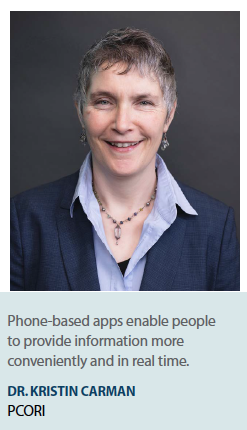 PCORI helped develop PCORnet, the National Patient-Centered Clinical Research Network. PCORnet is a collaboration of 33 diverse research networks, several of which are using mobile technology to engage patients.
PCORI helped develop PCORnet, the National Patient-Centered Clinical Research Network. PCORnet is a collaboration of 33 diverse research networks, several of which are using mobile technology to engage patients.
“PCORnet unites patients, clinicians, health systems, health plans, and researchers from across the nation in collaborative partnerships to enable research to be conducted faster, less expensively, and on a larger scale than has been possible previously," Dr. Carman says. “Dozens of PCORI projects make use of data from thousands of patients, combining and analyzing the data using sophisticated computer programs while protecting patient privacy and confidentiality."
Advancements in consumer technologies are continually improving how sponsors engage with clinical trial patients.
“For example, enhanced apps that use different media types and voice assistance systems, such as Amazon Echo, enable sponsors to simplify trial participation and provide meaningful support while capturing important patient-reported outcomes data," says Chris Watson, Ph.D., director of product strategy, digital patient, ERT.
“These tools also enable sponsors to include patients with reduced dexterity, for example Parkinson’s disease and rheumatoid arthritis sufferers, who might otherwise be excluded from trial participation due to their limitations in using the web or smartphones for this data exchange," he says.
Industry experts say pharmaceutical companies can’t discount the power of the Web and social media to inform clinical trial development and patient engagement. There are many news tools that can help companies source patient input compliantly.
“Information technology is rapidly evolving and changing how things get done, even with patient organizations and their operations, so the industry can’t be afraid to lean into this new reality," says Jeffery Sherman, M.D., executive VP, chief medical officer, Horizon Pharma.
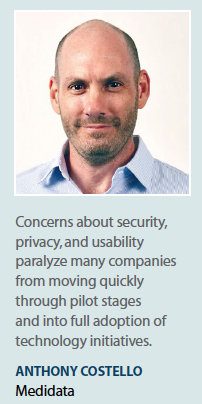 Horizon Pharma is working to make sure the patients’ perspective, voices, and experiences are the primary force driving the drug development process and regulatory decision-making.
Horizon Pharma is working to make sure the patients’ perspective, voices, and experiences are the primary force driving the drug development process and regulatory decision-making.
“Scientific and medical perspectives can’t be the only integral voices in the process any more; patients and patient groups should be involved at many stages of a clinical trial, from designing the study to identifying and recruiting participants, to providing input to regulatory agencies on which outcomes are most important to patients," he says.
Another company engaging patients through technology is Genentech. The company has developed a smartphone technology called Floodlight that monitors disability progression in patients with multiple sclerosis. Genentech has begun testing this in clinical trials and is gathering patient information with a smartphone technology. Researchers are comparing the information obtained in the study with what physicians record during patient visits. The research team believes this method may be able to detect changes in a patient’s disability between clinic visits and could provide better information for a clinician or researcher, which may help identify predictor of disease activity and eventually impact long-term patient outcomes.
The smartphone app complements the standard metrics that are used in a clinic, such as the nine-hole peg test or the 25-foot walking test that typically happen once or twice a year, says Donna Masterman, M.D., medical affairs, Genentech.
Dr. Masterman says being patient-centric can mean looking at how sponsors can take away some of the burden of clinical trials on the patient, like using a tool such as an app or smartphone device that can help gather information about a patient’s disease progression.
“This smartphone technology is more than an app," she says. “It’s not just passive monitoring that’s captured on the phone. There are other components to it that give you a lot of detail about the patient’s activity; it’s a very robust tool."
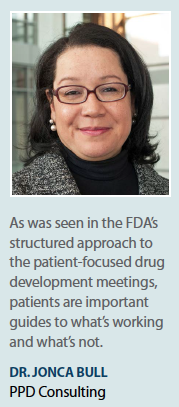 In addition, online communities such as Facebook are being leveraged to increase patient access to information and communication regarding clinical trials, as well as providing information/guidance to subjects enrolled on clinical trials, says Sandy Smith, VP of U.S. oncology research for McKesson Specialty Health and The US Oncology Network.
In addition, online communities such as Facebook are being leveraged to increase patient access to information and communication regarding clinical trials, as well as providing information/guidance to subjects enrolled on clinical trials, says Sandy Smith, VP of U.S. oncology research for McKesson Specialty Health and The US Oncology Network.
“Leveraging technology platforms such as patient portals, apps, online social communities, and mobile devices such as tablets or iPads are great examples of how to share information with patients about clinical trials at the sites of care where they are being seen," Ms. Smith says.
“Patient portals are often connected with the electronic health record, which can help with identification of eligible candidates for clinical trial matching. Using intelligence such as demographics, communications preferences, and treatment journeys to understand patients will help to inform the best approach to engage with patients and their caregivers about clinical trials and many other aspects of the patient journey."
But technological advancements alone don’t make trials patient-centric, Mr. Chateau says.
“Instead of focusing on broader deployment of technology, study investigators should be focusing on whether the technology being used accurately addresses patients’ needs," he says. “The only way to do that is to integrate feedback from patients at the earliest stages regarding various factors, including type of technology, current tech behaviors, and the ecosystem in which the technology will be used. Although many studies include patient input regarding technology use, it doesn’t happen until late in the process, when their input will have minimal impact on study plans."
Mr. Chateau says every trial should leverage a patient voice team or patient input circle, so to speak, that allows for feedback — including technology use — from the very beginning.
“Some fear integrating patient feedback will make the whole trial process last even longer; however, if investigators take time to tweak trial protocols and processes from the outset by including patient feedback, they will gain time and momentum on the back end because buy-in from patients will be far greater," he says. “In fact, 66% of chronic disease patients in our polls reported they would be more likely to participate in clinical trials knowing that other patients had been involved in planning and review of the study."
Mr. Chateau says the lion’s share of these technology efforts are single-minded, focusing mostly on data collection.
“The purpose of mobile engagement becomes to make data capture cleaner and improve data analysis, not necessarily to provide qualitative feedback related to the trial experience or to help patients feel their needs are being met," he says. “As a result, clinical trials are becoming more technology-centric, but not necessarily more patient-centric."
He says to make 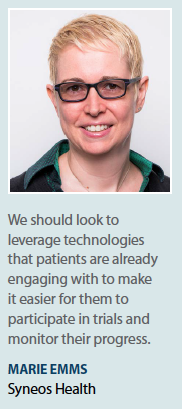 any of these efforts truly engaging — whether eConsent or mobile apps — investigators must incorporate patient voices into the design and execution of clinical trials, including the technology used.
any of these efforts truly engaging — whether eConsent or mobile apps — investigators must incorporate patient voices into the design and execution of clinical trials, including the technology used.
“I often say technology is the enabler of change, not the change itself; patient feedback is the driver of change," he says. “Incorporating this input, including the feelings and emotions of the people who are affected by health conditions, will drive meaningful improvements in clinical trials and enable technology to be more efficient and effective in engaging patients."
The biggest issue, Mr. Chateau says, is that patient feedback is not incorporated into how and when these technologies are used — especially not early enough in the process — to have meaningful impact on the planning and execution of the trial.
“For marketers, being patient-centric is at its best a higher purpose, recognizing the essential humanity of the people we hope to serve," says Johanna Skilling, head of planning, Ogilvy CommonHealth Worldwide, a WPP Health & Wellness company.
“For us, patient-centricity is about human empathy," she says. “To do it well means making space in our internal cultures of marketing and strategy and tactics, the currency of our day-to-day professional lives — to center, to focus, to meet the essential humanness of the person whose life we hope to change for the better."(PV)
~~~~~~~~~~~~~~~~~~~~~~~~~
Patients’ Voices: Clinical Trial Technologies
 Grace Cordovano, Ph.D.
Grace Cordovano, Ph.D.
Enlightening Results
Cancer Patient Advocate
@GraceCordovan
Patients and their care partners need to be able to find and be connected to clinical trials without their efforts resembling Mission Impossible. Social media offers great opportunities to finding patients where they are. Traditional trials are designed to be conducted on the premises of larger academic and urban hospital centers. Unfortunately, life happens outside of the confines of those perimeters. Trials must be designed not only to meet statistically significant clinical endpoints, but also to assimilate within the context of an ongoing life. A person’s life does not stop because they (or their loved one) are participating in a clinical trial, but those participants, and their care partners, often have to pull out all the stops to participate in a trial. This is not sustainable and is an outdated, unrealistic model.
 Starla Espinoza
Starla Espinoza
Multiple Sclerosis Patient
facebook.com/curemsnow
In today’s society everyone including patients love using social media as a source of information. All platforms of social media, email communication, and monthly newsletters mailed directly to the patients should be used to engage patients.
 Dima Hendricks
Dima Hendricks
Patient Leader
Sickle Cell Anemia Patient
@DimaHendricks
Although there are more opportunities for technological advances, pharma and technology companies need to address the lack of minority representation within clinical trials. Minority presence is essential in trials and makes the potential treatment relevant to the entire population. To ensure the recruitment and retention of minority participants, pharma and technology companies need to find strategies for gaining minority trust.
 Candace Lerman
Candace Lerman
Health Policy Consultant
Immune Thrombocytopenia Patient
@RareCandace
An app that would allow patients/family/caregivers to document side effects whether positive or negative is needed. It can help researchers, doctors, and ultimately the FDA look at the data to approve drugs. Social media is the central part of engaging with patients. I hope it expands and continues.
 Whitney Petit
Whitney Petit
Epilepsy Patient Leader
Epilepsy
@cfepilepsy
Creating a platform where data can be shared between patients, pharma companies, and physicians could lead to a more patient-centric trial. Signing up at the beginning of a trial and only hearing from everyone involved at the end or during appointments can cause a patient to feel like another number. With the advancement of technology today, the patient’s voice can be made louder than ever with an all-hands approach.
 Lilly Stairs
Lilly Stairs
Head of Patient Advocacy, Clara Health
Autoimmune Disease Patient
@LillyStairs
Pharma and CROs are not meeting patients where they are, and they are not engaging in a genuine way. While I understand there are legal and regulatory concerns, pharma companies need to step out of their contrived language bubble and communicate in a way that resonates with patients.
Have you seen clinicaltrials.gov? Poor technology riddled with language that is impossible to understand. Clinical trials are already a stigmatized treatment option. But by engaging with patients in venues where they are comfortable, whether that be online via social media or at in person events, using approachable language and collaborating with patient opinion leaders, we can help empower communities with the knowledge that clinical trials are an option.
 Maria Thomas
Maria Thomas
Hyperhidrosis Patient
@MyLifeAsAPuddle
Influencer marketing is where it’s at. Identifying health ambassadors and tapping into their audiences directly will drive trial registration and patient compliance. Finding authentic people who represent health conditions in a meaningful and engaging way and who use their social media platforms for good should be the next natural step in spreading clinical trial awareness. This is the type of influence that matters.
~~~~~~~~~~~~~~~~~~~~~~~~~
Case Study: How Bristol-Myers Squibb Deploys Technology for Patient-Centered Trials
For Patients
 Bristol-Myers Squibb is directly supporting patients throughout the clinical trial process through the use of technology. This is a key driver of the company’s work on Study Connect, a website that it first developed in 2011 as a resource for patients to learn about clinical trial options. The company is introducing important new features this spring. The features are intended to make Study Connect a resource to support patients before, during, and after a clinical trial.
Bristol-Myers Squibb is directly supporting patients throughout the clinical trial process through the use of technology. This is a key driver of the company’s work on Study Connect, a website that it first developed in 2011 as a resource for patients to learn about clinical trial options. The company is introducing important new features this spring. The features are intended to make Study Connect a resource to support patients before, during, and after a clinical trial.
One new feature will be a peer-to-peer online community for people to talk with one another regarding clinical trial participation. This will give people a direct way to ask about experiences in trials and how they were able to participate in light of all of the other things happening in their day to day lives.
“One truly patient-centric new feature on the website relates to search results," says Liz Beatty, director of digital clinical trials at Bristol-Myers Squibb. “If a patient does not find a BMS study through our condition-specific screeners, the search results will share publicly available information regarding trials from other sponsors for consideration — based on trial criteria from clinicaltrials.gov. We think it is important to help patients who want to explore clinical trials to find the best possible option."
In addition to connecting patients to clinical trials, technology also enables new means of data collection directly from patients. These new capabilities can speed up the clinical trial process and allow for data collection in new and different ways, potentially reducing patient travel and/or enabling more robust data collection during the trial.
The company is looking at other patient-facing technologies to support patients in their clinical trial experience. Some examples include:
eConsent: BMS has learned a lot over the years regarding using electronic informed consent (eConsent). The company’s experiences, coupled with its involvement with industry consortiums, have led to broader eConsent use across the clinical trial portfolio.
ePRO: BMS is also exploring ways to use electronic capture of patient reported outcomes (ePRO) more broadly. This is important technology to engage with patients about their own outcomes during the clinical trial, and it helps further understand the value of our medicines to patients. BMS believes the electronic capture of this data will lead to faster data collection and availability of this important data.
“We are also running a series of pilot projects related to patient-facing technology to improve the clinical trial experience and accelerate clinical trials," Ms. Beatty says. “This innovation program has been developed with patients and sites to improve patient access in clinical trials, and collect richer, broader data, and insights on outcomes. Technologies that demonstrate benefit in these pilots will be considered for broader use in our programs."
For Sites
With any new technology, it is important that companies consider the impact to study site staff as well. New technologies need to help both the patient and the study site for clinical trials to be successful. This is why it is so important to develop an approach with patient and sites in mind.
An example of this can be seen in one of the new features on Study Connect. On the website, patients will be able to search and pre-screen for BMS clinical trials based on a number of criteria and can then indicate their interest in the clinical trial by registering on the website to be contacted by the site. This enables the patient to see the BMS trials that are best matched to his or her criteria, and the study site to receive registration from patients who are most likely to meet the study criteria. This enhanced capability can support a better experience for both site and patient.
“To truly be patient-centric with new technology, we need to consider the different needs of people who may participate and provide technology options that will support a diverse group of people around the world," Ms. Beatty says. “We should not assume everyone has the same access, connectivity, or willingness to use technology. These are considerations that are being taken as we expand Study Connect."
ams."
For Sites
With any new technology, it is important that companies consider the impact to study site staff as well. New technologies need to help both the patient and the study site for clinical trials to be successful. This is why it is so important to develop an approach with patient and sites in mind.
An example of this can be seen in one of the new features on Study Connect. On the website, patients will be able to search and pre-screen for BMS clinical trials based on a number of criteria and can then indicate their interest in the clinical trial by registering on the website to be contacted by the site. This enables the patient to see the BMS trials that are best matched to his or her criteria, and the study site to receive registration from patients who are most likely to meet the study criteria. This enhanced capability can support a better experience for both site and patient.
“To truly be patient-centric with new technology, we need to consider the different needs of people who may participate and provide technology options that will support a diverse group of people around the world," Ms. Beatty says. “We should not assume everyone has the same access, connectivity, or willingness to use technology. These are considerations that are being taken as we expand Study Connect."
















